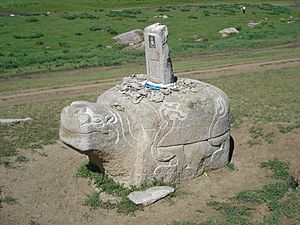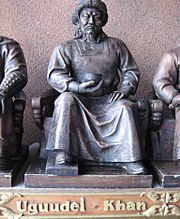Ögedei Khan facts for kids
Quick facts for kids ᠥᠭᠡᠳᠡᠢ ᠬᠠᠭᠠᠨÖgedei Khagan |
|||||||||
|---|---|---|---|---|---|---|---|---|---|
|
|||||||||

A portrait of Ögedei produced during the Yuan dynasty. The original size is 47 cm wide and 59.4 cm high, and produced with paint and ink on silk. It is now located in the National Palace Museum, Taipei, Taiwan.
|
|||||||||
| 2nd Khagan-Emperor of the Mongol Empire | |||||||||
| Reign | 13 September 1229 – 11 December 1241 | ||||||||
| Coronation | 13 September 1229 in Khuruldai at the Kherlen's Khödöö Aral, present-day Mongolia | ||||||||
| Predecessor |
|
||||||||
| Successor |
|
||||||||
| Born | c. 1186 Khamag Mongol |
||||||||
| Died | 11 December 1241 (aged 55) Mongol Empire |
||||||||
| Burial | Unknown, presumptively Burkhan Khaldun (in present-day Khentii Province, Mongolia) | ||||||||
| Consort |
|
||||||||
| Issue |
|
||||||||
|
|||||||||
| Dynasty | Borjigin | ||||||||
| Father | Genghis Khan | ||||||||
| Mother | Börte Ujin | ||||||||
| Religion | Tengriism | ||||||||
Ögedei Khagan (born around 1186 – died December 11, 1241) was the second supreme leader, or Khagan, of the Mongol Empire. He was the third son of Genghis Khan, the famous founder of the Mongol Empire. Ögedei continued his father's work, expanding the empire even further.
He was born around 1186 AD and fought in many battles as his father rose to power. After his father's death in 1227, Ögedei was chosen as the new Khagan in 1229. This happened after a two-year period where his younger brother, Tolui, ruled as a temporary leader.
As Khagan, Ögedei kept expanding the empire. He sent armies to invade Persia, Korea, and parts of China and India. By the time he died in 1241, Mongol armies had also conquered parts of Europe, defeating forces in Poland and Hungary.
Ögedei was also a skilled administrator. He worked with smart officials to create systems for trade and tax collection. He also founded the Mongol capital city, Karakorum, in the 1230s. Even though his father, Genghis Khan, is more famous, Ögedei was known for being friendly, intelligent, and a good leader.
Contents
Early Life and Rise to Power
Ögedei was the third son of Genghis Khan and his first wife, Börte Ujin. He was part of the many important events during his father's rise. When Ögedei was 17, he was badly hurt in a battle against Jamukha's army. He was rescued by his father's adopted brother, Borokhula.
In 1206, after Genghis Khan was declared Emperor, Ögedei was given control over several groups of people and land. His territory was near the Emil and Hobok rivers. He also had a tutor named Ilugei, who was a commander of the Jalayir clan.
Ögedei and his brothers fought their first independent campaign in 1211 against the Jin dynasty in China. He led his forces to attack different parts of China. During the Mongol conquest of Khwarezmia, Ögedei helped capture the city of Urganch in 1221. His success in this siege showed his military skill.
Becoming the Next Leader
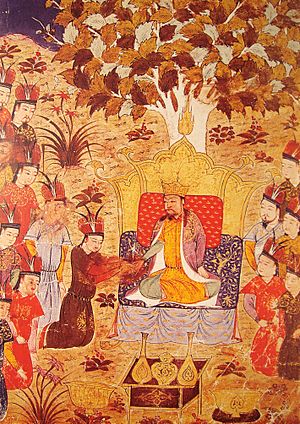
Before invading the Khwarezmid Empire in 1219, Genghis Khan's wife, Empress Yisui, wanted him to choose his successor. After his two older brothers, Jochi and Chagatai, argued, they agreed that Ögedei should be the next leader. Genghis Khan confirmed this choice.
Genghis Khan died in 1227. Ögedei's younger brother, Tolui, ruled temporarily until 1229. Ögedei was officially chosen as the supreme khan in 1229 at a big meeting called a kurultai. This meeting took place at Kodoe Aral on the Kherlen River. Ögedei was proclaimed Khagan of the Mongols on September 13, 1229.
Expanding the Mongol Empire
Ögedei continued his father's goal of expanding the Mongol Empire across the world.
Conquering the Middle East
After destroying the Khwarazmian empire, Genghis Khan planned to move against Western Xia. However, Jalal al-Din, the last Khwarizm ruler, tried to rebuild his empire in Persia. Mongol forces sent against him were defeated in 1227.
With Ögedei's approval, a Mongol general named Chormaqan led a large army into Persia in 1230. He quickly took control of Persia and Khorasan. By 1231, he had captured many cities. The local rulers often chose to pay tribute to the Mongols rather than have their lands destroyed. By 1240, all of Persia was part of the Mongol Empire.
The Fall of the Jin Dynasty
Ögedei also continued the war against the Jin dynasty in China. In 1230, he went south to Shanxi province with his brother Tolui. They cleared out Jin forces and captured the city of Fengxiang. By 1232, the Jin Emperor was trapped in his capital city of Kaifeng. Ögedei left the final conquest to his generals.
With help from the Song dynasty, the Mongols finally destroyed the Jin dynasty in February 1234. This happened after the fall of Caizhou. Ögedei also defeated the Eastern Xia in 1233, bringing southern Manchuria under Mongol control.
Taking Control of Georgia and Armenia
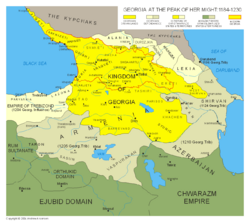
The Mongols, led by Chormaqan, returned to the Caucasus region in 1232. They captured cities like Ganjak in 1235. The people of Irbil agreed to pay a yearly tribute to the Mongols. In 1238, the Mongols captured Tiflis, the capital of Georgia. By 1240, Chormaqan had completed the conquest of Transcaucasia, forcing the Georgian nobles to surrender.
Invasions of Korea
In 1224, a Mongol messenger was killed in Korea, and Korea stopped paying tribute. Ögedei sent a general named Saritai to conquer Korea in 1231. The Mongol armies began to invade Korea. The Korean King temporarily surrendered and agreed to have Mongol overseers. However, the King later moved his capital to Ganghwa Island to avoid the Mongols.
In 1234, Ögedei announced plans to conquer the Koreans, the Southern Song, and other groups who had harmed Mongol messengers. The war with Korea continued until 1241, when the Korean king sent his relative and ten noble boys to Mongolia as hostages, bringing a temporary end to the fighting.
Mongol Armies in Europe
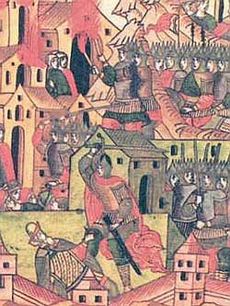
The Mongol Empire also expanded westward under the command of Batu Khan, Ögedei's nephew. They conquered parts of Volga Bulgaria, Alania, Cumania, and Rus' (modern-day Russia and Ukraine). They also briefly occupied Hungary. Mongol armies invaded Poland, Croatia, Serbia, Bulgaria, and Austria.
During these conquests, there were some disagreements among the Mongol leaders. Ögedei's son, Güyük, and Chagatai's grandson, Büri, made fun of Batu. Ögedei criticized Güyük for his behavior and sent him back to continue the conquest of Europe.
The Mongol advance into Europe stopped in early 1242, the year after Ögedei's death. Some historians believe the Mongols retreated because they needed to choose a new leader after Ögedei died. Others think the Mongols faced difficulties with supplies and strong European forts.
Conflicts with the Song Dynasty
From 1235 to 1245, Mongol armies led by Ögedei's sons attacked deep into the Song Dynasty in China. They reached cities like Chengdu and Xiangyang. However, they could not fully conquer the Song due to the climate and the large number of Song troops. Ögedei's son, Khochu, died during these campaigns.
The Mongol expansion across Asia under Ögedei helped bring political stability. It also helped reopen the Silk Road, which was a very important trade route between East and West.
Invasions of India
Ögedei sent Mongol forces into the Indus valley in the winter of 1241. They attacked Lahore, a city controlled by the Delhi Sultanate. However, the Mongol general Dayir Baghatur died during the attack. The Mongols then left the city after a fierce battle.
Around the same time, another Mongol force invaded Kashmir. Kashmir soon became a territory controlled by the Mongols.
How Ögedei Ruled the Empire
Ögedei began to organize the Mongol government more formally. He created three main groups to help him rule:
- Christian Turks: These included officials like Chinqai, a scribe from the Uyghur group.
- Islamic Officials: These included two men from Khorazm, Mahamud Yalavach and Masud Beg.
- North Chinese Scholars: These included Yelü Chucai, a Khitan, and Nianhe Zhong-shan, a Jurchen.
Mahamud Yalavach suggested a system where tax collection was given to private tax collectors. Yelü Chucai, however, wanted a traditional Chinese system where government agents collected taxes using government money. Ögedei also invested in trading businesses called ortoq. The Mongols also started using paper money that was backed by silver.
Ögedei divided the Mongol-ruled parts of China into ten regions. He also set up separate administrations for different areas, like Beshbalik and Yanjing. He appointed Shigi Khutugh as the chief judge in China. In Iran, he appointed honest administrators like Chin-temur and Korguz.
Ögedei made sure that imperial princes were taught by scholars. He also built schools and an academy. He ordered that paper money be issued and created a department to manage it. Ögedei also made rules about how Mongol nobles could appoint officials and collect taxes in their lands.
He also created a system of post stations called Yam across the empire in 1234. These stations provided fresh horses and supplies for messengers. This helped messages travel quickly across the vast empire. Ögedei also made rules about what nobles could and could not do, like issuing special tablets that demanded goods from people.
Building Karakorum, the Capital
From 1235 to 1238, Ögedei built many palaces and buildings along his yearly travel route in central Mongolia. The first palace was built by craftsmen from North China. Ögedei encouraged his relatives to build homes nearby.
The city of Karakorum (Хархорум) was finished in 1235. It had different areas for Islamic and North Chinese craftsmen. The city was surrounded by earthen walls with four gates. Ögedei also built places of worship for his Buddhist, Muslim, Taoist, and Christian followers.
Ögedei's Personality
Ögedei was known for being a humble person. He didn't think he was a genius and was always willing to listen to his skilled generals. He was a leader, but not a dictator. Like other Mongols of his time, he was trained as a warrior from a young age. He was practical and focused on achieving goals.
His steady and reliable character was what his father valued most. This helped him become the next leader, even though he had two older brothers. Ögedei was considered his father's favorite son since childhood. As an adult, he was known for his ability to convince people in discussions because of his strong personality.
He was described as a physically large, cheerful, and friendly man who enjoyed life. He was intelligent and had a stable character. His friendly nature helped him keep the Mongol Empire united and following his father's plans. Ögedei knew he wasn't as great a military commander or organizer as his father, so he relied on the skills of others.
Ögedei died on December 11, 1241. Some historical accounts describe him as having a stocky build, a red beard, and hazel eyes. Chinese writers of the time noted his unusual beard, as most Mongols had little facial hair.
Death and What Happened Next
In the early 1230s, Ögedei had chosen his son Kuchu to be his heir. After Kuchu died in 1236, he named his grandson Shiremun as his successor. However, his choice was not set in stone for the Mongols.
After Ögedei's death, his widow, Töregene Khatun, ruled as a temporary leader for five years. Eventually, Ögedei's son, Güyük Khan, became the next Khagan. However, Batu Khan, the leader of the Golden Horde, did not fully accept Güyük. Güyük died while traveling to meet Batu. It wasn't until 1255, during the rule of Möngke Khan, that Batu felt secure enough to plan another invasion of Europe, but he died before he could do it.
When Kublai Khan started the Yuan dynasty in 1271, he officially recognized Ögedei Khan with the temple name Taizong (太宗).
Family
Like his father, Ögedei had many wives and concubines. His main wives included Boraqchin and Töregene.
His notable children included:
- Güyük Khan – who became the 3rd Great Khan of the Mongols.
- Koden – known as the first Buddhist Mongol prince.
- Köchü – who died during a campaign in China. His son, Shiremün, was chosen by Ögedei as his heir.
- Kadan
Legacy
Mongolian Airlines named one of its planes, a Boeing 737-800, "Ogoodei Khan" in his honor.
See also
 In Spanish: Ogodei para niños
In Spanish: Ogodei para niños
- House of Ögedei
- Battle of Dachangyuan


